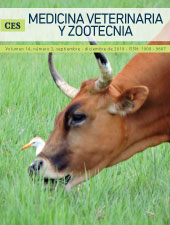Diferencias en los polimorfismos de genes asociados al control del desarrollo folicular entre búfalos (Bubalus bubalis) y vacunos (Bos indicus)
DOI:
https://doi.org/10.21615/cesmvz.14.3.5Resumen
Se han encontrado asociaciones entre polimorfismos genéticos y parámetros reproductivos, adicioalmente este abordaje permitiría proponer explicaciones a los fenómenos estudiados. FSHr, InhA, AMH y AMHr son genes asociados al desarrollo folicular, que tienen una alta homologia y la misma función en bovinos. El objetivo del presente trabajo fue evaluar en bovinos muy relacionados si se encuentran algunos polimorfismos asociados a parámetros reproductivos reportados en otras especies. Durante el 2018, en el Magdalena Medio Colombiano fueron tomadas muestras de sangre anticoagulada de 50 búfalas y 50 vacas cebú comercial (Bos indicus). Se registró la paridad, días abiertos, intervalo parto primer servicio y edad al primer parto de cada animal, sin alteraciones anatómicas, con edad y peso similar, mantenidos en las mismas condiciones de alimentación y manejo. Se extrajo el ADN por el método de Salting out y se evaluaron los polimorfismos de acuerdo con lo reportado en la literatura. Se compararon los datos usando la prueba Mann Whitney, se consideró significativo un valor de p<0,05. Se encontró que los búfalos tienen menores niveles de AMH, edad al primer parto, intervalo ente partos que las vacas (p<0.001), mayor paridad (p=0.005). No se confirmaron los polimorfismos reportados en holstein y en humanos en ninguna de las muestras y especies analizadas. No confirmar los polimorfismos hallados por otros autores en bovinos de otras razas y especies, aún mostrando que tienen diferentes parámetros reproductivos , muestra la necesidad de replantear el abordaje del estudio de los asociación de los fenómenos reproductivos y genéticos.
Differences in polymorphisms of genes associated with follicle development control between buffaloes (Bubalus bubalis) and cattle (Bos indicus)
Associations have been found between genetic polymorphisms and reproductive parameters, this approach additionally would allow us to propose explanations to the phenomena studied. FSHr, InhA, AMH and AMHr are genes associated with follicular development, which have a high homology and the same function in bovines. The objective of this work was to evaluate if some polymorphisms described in other species associated with reproductive parameters are found in two closely related bovines. During 2018, in the Colombian Magdalena Medio anticoagulated blood samples from 50 buffaloes (Bubalus bubalis) and 50 commercial zebu cows (Bos indicus) were taken. All animals without anatomical abnormalities and similar weight and age were taken and the. parity, intercalving period and age at first calving were also recorded. DNA were extracted using Salting out method and the reported polymorphisms of the above mentioned genes were evaluated. Data were compared using Mann Whitney test and p<0.05 value were considered significant. Buffaloes have lower AMH levels, age at first calving, calving interval than Bos indicus cows (p<0.001) and higher parity (p=0.005). The polymorphisms reported in Holstein and humans were not confirmed in any of the samples and species analyzed. The results, are in some way parodoxical because there are differences in reproductive parameters but nothing different in the studies genes. It shows the need to rethink the approach of the study of the association of reproductive and genetic phenomena.
Keywords: AMH, AMHr, Buffaloes, FSHr, InhA, Polymorphisms.
Diferenças nos polimorfismos genéticos associados ao controle do desenvolvimento folicular entre búfalos (Bubalus bubalis) e bovinos (Bos indicus)
Foram encontradas associações entre polimorfismos genéticos e parâmetros reprodutivos; essa abordagem também permitiria propor explicações para os diferentes fenômenos estudados. FSHr, InhA, AMH e AMHr são genes associados ao desenvolvimento folicular, que apresentam alta homologia e a mesma função em bovinos. O objetivo do presente trabalho foi avaliar em bovinos intimamente relacionados se alguns polimorfismos associados a parâmetros reprodutivos relatados em outras espécies. Em 2018, 50 vacas de búfalo (Bubalus bubalis) e 50 de zebu comerciais (Bos indicus) foram amostradas na Magdalena Medio colombiana. Foram registradas paridade, dias abertos, intervalo de nascimento do primeiro serviço e idade no primeiro nascimento de cada animal, sem alterações anatômicas, com idade e peso semelhantes, mantidas nas mesmas condições de alimentação e manuseio. O DNA foi extraído pelo método Salting out e os polimorfismos foram avaliados de acordo com o relatado na literatura. Os dados foram comparados pelo teste de Mann Whitney, sendo considerado significativo um valor de p <0,05. Verificou-se que os búfalos apresentam níveis mais baixos de AMH, idade do primeiro nascimento, intervalo entre os nascimentos que as vacas (p <0,001), maior paridade (p = 0,005). Os polimorfismos relatados em Holstein e em humanos não foram confirmados em nenhuma das amostras e espécies analisadas. A não confirmação dos achados em bovinos de outras raças e espécies, embora as espécies possuam diferentes parâmetros reprodutivos, mostra a necessidade de repensar a abordagem do estudo da associação dos fenômenos reprodutivos e genéticos.
Palavras-chave: AMH, AMHr, buffalo, FSHr, InhA, polimorfismos.
Descargas
Referencias bibliográficas
World Health Organization.Global Tuberculosis Report [Internet]. Geneva, Switzerland.; 2017. Available from: http://www.who.int/tb/publications/global_report/es/
Kibirige d. Sskitoleko, r. Worodria, W. Tuberculosis and Diabetes Mellitus Interaction. Infect Dis ClinPract 2013; 21: 355Y358
Delgado R., Juan L., Seclen S., Segundo N., Gotuzzo H., Eduardo. Tuberculosis en pacientes con diabetes mellitus: Un estudio epidemiológico y clínico en el Hospital Nacional Cayetano Heredia. Rev Med Hered. 2006 (3)
Barceló A Rajpathak S. Incidence and prevalence of diabetes mellitus in the Americas. Revista Panamericana de Salud Pública. 2001; 10(5):300-308.
World Health Organization. Global report on diabetes [Internet]. Geneva, Switzerland.; 2016. Available from: http://www.who.int/mediacentre/factsheets/fs312/en/Geneva, Switzerland.
Wild S, Roglic G, Green A, et al. Global prevalence of diabetes: estimates for the year 2000 and projections for 2030. Diabetes Care. 2004; 27: 1047 Y 1053.
Global status report on noncommunicable diseases 2014. Geneva, World Health Organization, 2012.
ROOT H. The Association of Diabetes and Tuberculosis. New England Journal of Medicine. 1934; 210(2):78-92.
Balakrishnan S, Vijayan S, Nair S, Subramoniapillai J, Mrithyunjayan S, Wilson N et al. High Diabetes Prevalence among Tuberculosis Cases in Kerala, India. PLoS ONE. 2012; 7(10):e46502.
Oscarsson P, Silwer H. II Incidence of Pulmonary Tuberculosis among Diabetics. Acta Medica Scandinavica. 2009; 161:23-48.
Jeon C, Murray M. Diabetes Mellitus Increases the Risk of Active Tuberculosis: A Systematic Review of 13 Observational Studies. PLoS Medicine. 2008;5(7):e152.
Pablos-Mendez, A., Blustein, J., &Knirsch, C. A. The role of diabetes mellitus in the higher prevalence of tuberculosis among Hispanics. American Journal of Public Health. 1997; 87(4), 574-579.
Kim, S. J., Hong, Y. P., Lew, W. J., Yang, S. C., & Lee, E. G. Incidence of pulmonary tuberculosis among diabetics. Tubercle and lung disease. 1995; 76(6), 529-533.
Restrepo, B. I., Camerlin, A. J., Rahbar, M. H., Wang, W., Restrepo, M. A., Zarate, I. & Fisher-Hoch, S. P. (2011). Cross-sectional assessment reveals high diabetes prevalence among newly-diagnosed tuberculosis cases. Bulletin of the World Health Organization, 2011, 89(5), 352-359.
Suwanpimolkul, G., Grinsdale, J. A., Jarlsberg, L. G., Higashi, J., Osmond, D. H., Hopewell, P. C., & Kato-Maeda, M. (2014). Association between Diabetes Mellitus and Tuberculosis in United States-Born and Foreign-Born Populations in San Francisco. PLoS ONE, 2014, 9 (12), e 114442.
Martínez-Aguilar, G., Serrano, C. J., Castañeda-Delgado, J. E., Macías-Segura, N., Hernández-Delgadillo, N., Enciso-Moreno, L.,.&Enciso-Moreno, J. A. (2015). Associated Risk Factors for Latent Tuberculosis Infection in Subjects with Diabetes. Archives of medical research. 2015
Delgado-Sánchez, G., García-García, L., Castellanos-Joya, M., Cruz-Hervert, P., Ferreyra-Reyes, L., Ferreira-Guerrero, E. Jiménez-Corona, M. E. (2015). Association of Pulmonary Tuberculosis and Diabetes in Mexico: Analysis of the National Tuberculosis Registry 2000–2012. PLoS ONE, 10(6), e0129312.
Martinez Purgarin D. Rico Gallego, J. Vera Polanía. Gaviria, J. Rodriguez Morales, A. (2014). Comorbilidad De Tuberculosis Y Diabetes En Un Hospital De Colombia. Rev Peru Med Exp Salud Pública; 2014 31(2):393-401.
Base de datos: http://www.dadiscartagena.gov.co
Deshmukh PA, Shaw T: Pulmonary tuberculosis and diabetes mellitus. Ind J Tub 1984, 31:114–117.
Baghaei Parvaneh, Marjani Majid, Javanmard Pedram, Tabarsi Payam and Masjedi Mohammad Reza Diabetes mellitus and tuberculosis facts and controversies. Journal of Diabetes & Metabolic Disorders 2013, 12:58
Usmani Rabia Arshed, Nasir Muhammad Ijaz, Wazir Salim, Pervaiz Zarabia , Zahra Taskeen, Akhtar Mehwish. Diabetes mellitus among tuberculosis patients in a tertiary care hospital of Lahore. J Ayub Med Coll Abbottabad 2014;26(1)
Magee MJ, Bloss E, Shin SS, Contreras C, Huaman HA, Ticona JC, et al. Clinical characteristics, drug resistance, and treatment outcomes among tuberculosis patients with diabetes in Peru. Int J Infect Dis. 2013;17(6):e404-12.
Alisjahbana B, Sahiratmadja E, Nelwan EJ, Purwa AM, Ahmad Y, Ottenhoff TH, Nelwan RH, Parwati I, van der Meer JW, Van Crevel R: The effect of type 2 diabetes mellitus on the presentation and treatment response of pulmonary tuberculosis. Clin Infect Dis 2007, 45(4):428–435
Magee J., Foote M, Maggio D, Howards P., Narayan V., Blumberg H., Ray S., Kempker R. Diabetes mellitus and risk of all-cause mortality among patients with tuberculosis in the state of Georgia, 2009e2012. Annals of Epidemiology (2014)
OMS | HABLEMOS DE TUBERCULOSIS Y VIH [Internet]. Who.int. 2018 [cited 1 March 2018]. Available from: http://www.who.int/tb/challenges/hiv/talking_points/es/
Ruslami R, Aarnoutse RE, Alisjahbana B, van der Ven AJ, Van Crevel R:Implications of the global increase of diabetes for tuberculosis control and patient care. Trop Med Int Health 2010, 15(11):1289–1299
Wild S, Roglic G, Green A, Sicree R, King H: Global prevalence of diabetes: estimates for the year 2000 and projections for 2030. Diabetes Care 2004, 27(5):1047–1053.
Restrepo BI: Convergence of the tuberculosis and diabetes epidemics: renewal of old acquaintances. Clin Infect Dis 2007, 45(4):436–438.
Tatar D, Senol G, Alptekin S, Karakurum C, Aydin M, Coskunol I: Tuberculosis in diabetics: features in an endemic area. Jpn J Infect Dis 2009, 62(6):423–427.
Descargas
Publicado
Cómo citar
Número
Sección
Licencia
Derechos de autor 2019 CES Medicina Veterinaria y Zootecnia

Esta obra está bajo una licencia internacional Creative Commons Atribución-NoComercial-CompartirIgual 4.0.
| Estadísticas de artículo | |
|---|---|
| Vistas de resúmenes | |
| Vistas de PDF | |
| Descargas de PDF | |
| Vistas de HTML | |
| Otras vistas | |



